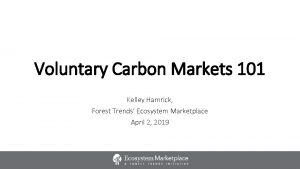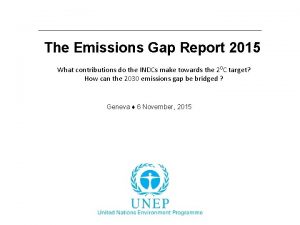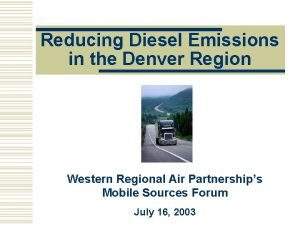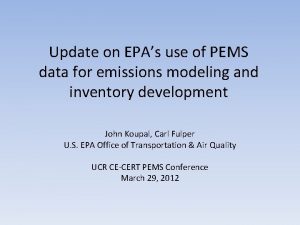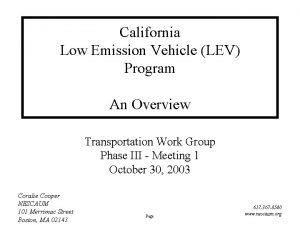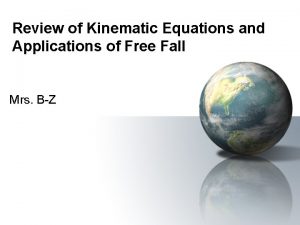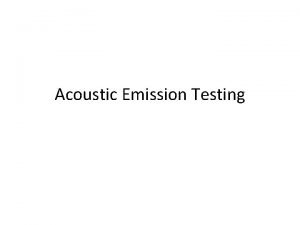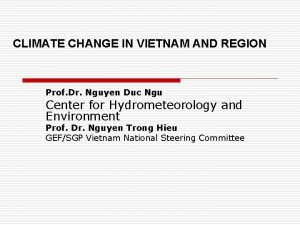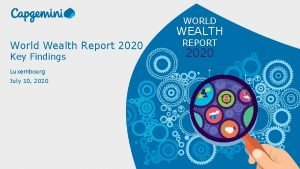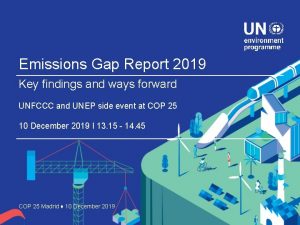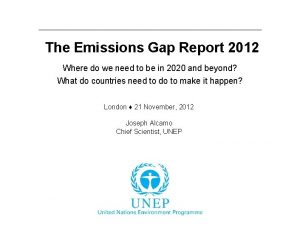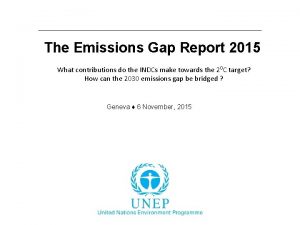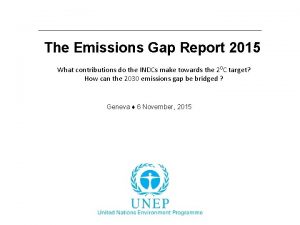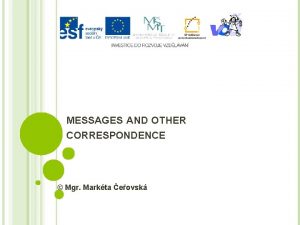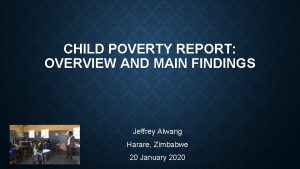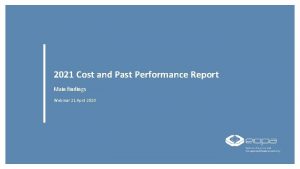Emissions Gap Report 2018 Main findings and messages




















- Slides: 20

Emissions Gap Report 2018 Main findings and messages Philip Drost Nairobi, 4 December 2018

Emissions Gap Report series The annual report describes - where we are likely to be: projected emissions after implemented climate plans - where we need to be: 1. 5°C or ‘well below 2°C’ Difference = ‘emissions gap’ In addition: features opportunities to bridge the gap 2018: strengthening climate plans, non-state actors, innovation, fiscal policy; 2017: CO 2 removal, coal phase-out 2018 is 9 th edition

Impact of the 2018 Report Probably the biggest impact of all Emissions Gap Reports. Downloads (up to 4 Dec 18) 13, 328 (report) and 14, 136 (executive summary) Unique editorial mentions 4, 200 (up 20% compared to 2017) Unique broadcast and radio hits 562 (up 20% compared to 2017) Agenda-setting at COP 24 numerous references in opening statements

Political context of this edition 2018: Talanoa Dialogue Sept 2018: Global Climate Action Summit Oct 2018: IPCC Special Report on 1. 5°C Nov 2018: Emissions Gap Report Dec 2018: UN Climate Conference Katowice Sept 2019: SG’s Climate Summit New York 2020: Communication of updated climate plans

Main take-aways of this year’s report 1. The emissions gap is much bigger than before. 2. There is new evidence that countries are not doing enough. 3. There is new evidence of how to bridge the gap.

Global emissions up again after stabilization 2014 - 2016: emissions relatively stable 2017: clearly up, to a record 53. 5 Gt. CO 2 e Reasons: higher GDP and slower decline in energy intensity Global emissions show no signs of peaking Already peaked: USA, EU, Russia (but going up again) By 2030 57 countries have peaked (60% global emissions) G 20: Argentina, India, Indonesia, Saudi Arabia, South Africa and Turkey show no sign of peaking

National climate plans (NDCs) Collectively, G 20 will achieve Cancun pledges by 2020… Except Canada, Indonesia, Mexico, Republic of Korea, South Africa, USA …but will not realize their current NDCs for 2030 • Argentina, Australia, Canada, EU 28, Republic of Korea, Saudi Arabia, South Africa, USA are not on track • Brazil, China, Japan on track • India, Russia, Turkey: >10% below their targets low ambition? • Indonesia, Mexico: unclear

The 2018 emissions gap

Emissions gap is bigger than previous years IPCC report: more caution about CO 2 removal, so more mitigation necessary

Effect of climate plans insufficient

Effect of climate plans insufficient +3. 2°C

3 x more ambition needed to fill the 2ºC gap

…and 5 x more to fill the 1. 5ºC gap

How to bridge the gap? Special topics this year: - Strengthening climate plans - Non-state and subnational action - Fiscal policy - The role of innovation

Strengthening climate plans: how? Increase ambition by: - Strengthening/adding a greenhouse gas target or a sectoral non-GHG target - Strengthening/adding policies and actions - Aligning NDC implementation with long-term goals Many technical options are economically feasible. 33 Gt. CO 2 e reduction possible enough to close the 2ºC gap

Non-state and subnational action Number of actors rising fast: 1000 s cities and companies, but still huge potential for expansion. Estimates on potential vary widely—but can be up to 19 Gt. CO 2 e by 2030 (enough to close the 2ºC gap) Proven impact so far very limited (0. 45 Gt. CO 2 e) due to lack of transparency.

Fiscal policy 15% of global emissions covered by 51 carbon pricing initiatives, 20% if China joins. Most countries’ fiscal policy not geared to deliver the transition to low-carbon economy: carbon prices too low, not aligned with climate goals. Carbon price of US$70/t. CO 2 leads to 10 -40% emission reduction. Consider a broad range of issues when introducing fiscal policy: equity, social acceptance, job creation, and many others.

The role of innovation Innovation has the potential to radically transform societies and reduce their emissions. Five success factors: - Government must take high, early-stage risk - Mid-way, governments must nurture feedback effects and help de-risk private investment - Set direction for the whole economy - Approach as mission-oriented innovation with concrete targets - Policy: bottom-up, participatory, long-term design Incredible development of solar panel deployment shows: public innovation policies crucial

Outreach material Available on unenvironment. org - Entire report, including annexes Executive Summary – in all UN languages E-book Key messages Press release Video Data visualization

Philip Drost Science Division / Scientific Assessment Branch philip. drost@un. org unenvironment. org/emissionsgap
 Un emissions gap report
Un emissions gap report Un emissions gap report
Un emissions gap report Dada la siguiente secuencia rusia 2018 rusia 2018
Dada la siguiente secuencia rusia 2018 rusia 2018 Qo'shma gap
Qo'shma gap A_______ bridges the specification gap between two pls.
A_______ bridges the specification gap between two pls. Volkswagen quiz
Volkswagen quiz Sparse matrix operator kernel emissions
Sparse matrix operator kernel emissions Diesel emissions denver
Diesel emissions denver Sources of nox emissions
Sources of nox emissions Parts of sperm cell
Parts of sperm cell Pems emissions modeling
Pems emissions modeling Where else have you observed colorful light emissions
Where else have you observed colorful light emissions Lev 2 emissions
Lev 2 emissions Luke autbeloe drops a pile of roof shingles
Luke autbeloe drops a pile of roof shingles Using citys heat reduce emissions
Using citys heat reduce emissions Acoustic emission testing applications
Acoustic emission testing applications Ghs emissions
Ghs emissions Splonc
Splonc Business communication chapter 6
Business communication chapter 6 Vce english study design 2023
Vce english study design 2023 Global wealth report 2020
Global wealth report 2020
